 When it comes to constructing a portfolio, I used to think it was all about numbers and optimization. When you pick an asset class based on historical data, that assumes you hold through both the good times and the really bad times. It has helped me to keep gathering nuggets of knowledge over time to maintain my faith during those really bad times.
When it comes to constructing a portfolio, I used to think it was all about numbers and optimization. When you pick an asset class based on historical data, that assumes you hold through both the good times and the really bad times. It has helped me to keep gathering nuggets of knowledge over time to maintain my faith during those really bad times.
I’d like to start a series of posts to document why I own each specific asset class. Somebody asked me about TIPS the other day, so I’ll start with them. I’m not an investing professional, just a semi-retired DIY investor who wants to keep on learning and would like to share with other like-minded folks. I won’t get into the tiny details, mostly a lot of charts, links, and higher-level ramblings.
Treasury Inflation-Protected Securities (TIPS) are bonds issued by the US government that pay interest which is linked to inflation. Inflation is measured by the Consumer Price Index (CPI). In terms of a useful all-around primer, this Morningstar (M*) article 20 Years In, Have TIPS Delivered? covers a lot of the bases. For more nuts-and-bolts mechanics, see this older Vanguard paper Investing in Treasury Inflation Protected Securities. According to M*, TIPS currently make up about 9% of the overall Treasury market.
Here are my reasons for owning Treasury Inflation-Protected Securities (TIPS):
TIPS are backed by the US Government, just like the more common “vanilla” US Treasury bonds. With bonds, I prefer to stay on the safer end of the spectrum. Bonds are debt, and I don’t want to worry about if I get paid back. Buying US Treasury bonds is the lowest amount of credit risk possible.
TIPS provide a “real” inflation rate at purchase, which means it is guaranteed to provide a set return above inflation (before taxes) until maturity. Very few bonds are structured in this manner. In simplified terms, if the real interest rate is 2% and inflation is 3%, then the total interest paid will be 5%. Working backwards from that, you get the concept of breakeven inflation rate, or the expected inflation by the market (via M*):
The introduction of TIPS brought with it a market-determined observable real rate of interest, which is what the yield on a TIPS is. If you subtract the TIPS yield from the comparable-maturity nominal Treasury yield, you get the market’s inflation expectation over the period until maturity of these two bonds. This is called “breakeven inflation,” because it is the level of inflation at which returns for the nominal and inflation-indexed bonds should break even.
Here’s how the expected inflation and actual inflation compared for 5-year periods since 2003. For the most part, they have been pretty close:
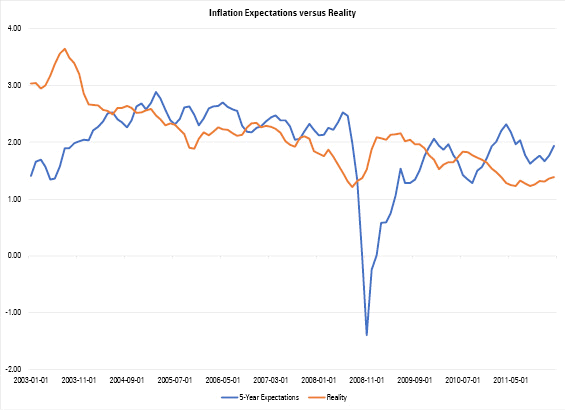
TIPS thus provides insurance against *unexpected* inflation. TIPS are often described as an inflation hedge, but it’s more of a hedge against unexpected inflation. All bonds are already priced with inflation in mind. If everyone thinks inflation will be high, then bonds across the board will be priced to pay out more interest to counter that.
The reason why you don’t hear much about TIPS in the media is that over the last several years, there hasn’t been any unexpected inflation. If you bought fire insurance on your house, and your house hasn’t burned down yet, are you going to stop buying the fire insurance?
TIPS also provides a certain amount of protection in case of severe deflation. TIPS are guaranteed to return par at maturity, meaning they have floor value even in a case of severe deflation. This asymmetry helps make TIPS attractive relative to Treasuries, as best explained by this EconompicData post:
Thus, assuming a view that an inflationary and deflationary scenario are equally likely, the unlimited potential outperformance of TIPS vs. Treasuries in an inflationary environment and limited upside of Treasuries vs. TIPS in a deflation environment would sway an investor towards TIPS.
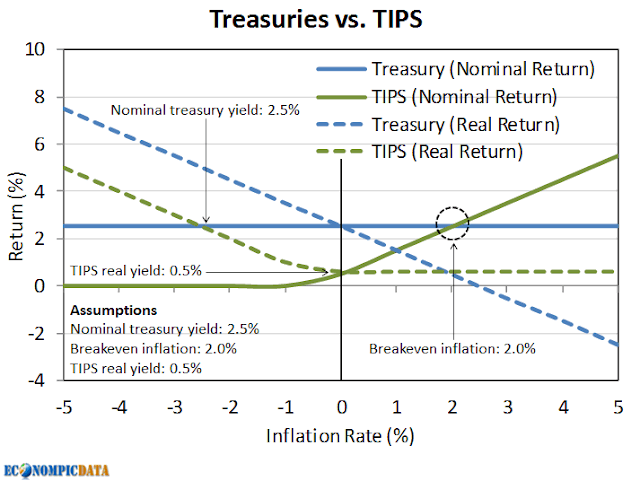
If inflation meets the market expectations, then TIPS and Treasuries will have the same return. If actual inflation is higher than the (expected) breakeven inflation rate, then TIPS will pay more than the regular Treasury bond. If actual inflation is less than the (expected) breakeven inflation rate, then TIPS will pay less than the regular Treasury bond. Here’s a simple graphic from AAII:
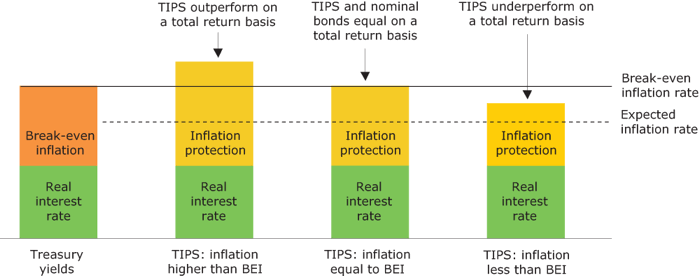
Here’s a 2008-2018 Morningstar chart comparing the growth of $10,000 between the Vanguard Intermediate Treasury Fund (VFITX) and the Vanguard Inflation-Protected Securities Fund (VIPSX). You can see while there is definitely a difference – sometimes one leads, sometimes the other – but over the last 10 years the net return has been very similar. Again, inflation has not been much higher (or a lot lower) than expected.
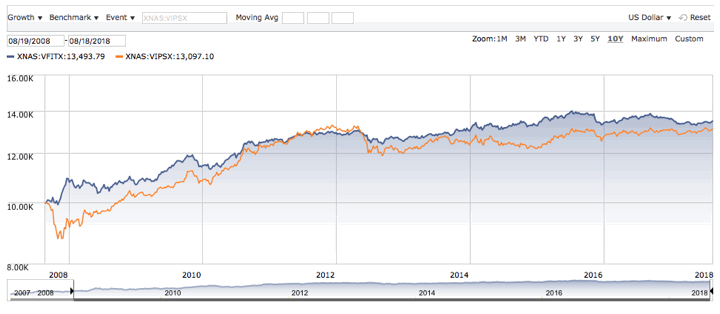
Do you think future inflation will be higher than the current expected number? Here’s the 5-year breakeven inflation rate for the last couple of years. Via WSJ Daily Shot.
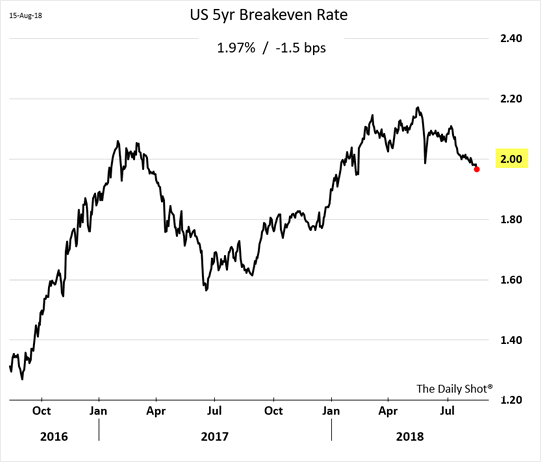
If I had to bet, I would bet that the future inflation number will be higher than 2% then less than 2%. However, most likely they will return around the same amount. So this is not a huge risky bet. In terms of the big picture, it’s a relatively wimpy bet. I currently hold about 1/3rd of my portfolio asset allocation in bonds, and about 1/3rd of those bonds are invested in TIPS. That means about 11% of my total portfolio is in TIPS. If the real yields on TIPS were to go back higher to historical levels, I would go back up to 50% of bonds in TIPS.
Here are some reasons for NOT owning Treasury Inflation-Protected Securities (TIPS).
- TIPS are not part of the efficient frontier. If you run an mean-variance blah-blah-blah optimizer, you won’t find TIPS on the ideal risk/return curve.
- TIPS have a low historical correlation with stocks, but not as low as regular Treasuries – regular Treasuries are a better bet to go up when the stock markets crash.
- TIPS have only been around for 20 years. You might argue that they have not been tested in severe high-inflation environment.
- As with nominal Treasuries, the interest is taxable as ordinary income rates, not the lower dividend or long-term capital gains rates as with stock dividends. You’ll have to pay taxes on this interest every year – it can’t be deferred like if you buy a stock and hold it for a long time. If you buy individual TIPS, you’ll also have to pay income taxes on the inflation adjustment without actually getting the interest until maturity. This is called “phantom income” but can be avoided if you buy TIPS via an ETF or mutual fund. TIPS are thus generally recommended to be kept in tax-sheltered accounts. (TIPS interest is exempt from state and local taxes, however.)
- Some people worry that the government will fudge the CPI numbers if high unexpected inflation really becomes a problem.
 The Best Credit Card Bonus Offers – March 2024
The Best Credit Card Bonus Offers – March 2024 Big List of Free Stocks from Brokerage Apps
Big List of Free Stocks from Brokerage Apps Best Interest Rates on Cash - March 2024
Best Interest Rates on Cash - March 2024 Free Credit Scores x 3 + Free Credit Monitoring
Free Credit Scores x 3 + Free Credit Monitoring Best No Fee 0% APR Balance Transfer Offers
Best No Fee 0% APR Balance Transfer Offers Little-Known Cellular Data Plans That Can Save Big Money
Little-Known Cellular Data Plans That Can Save Big Money How To Haggle Your Cable or Direct TV Bill
How To Haggle Your Cable or Direct TV Bill Big List of Free Consumer Data Reports (Credit, Rent, Work)
Big List of Free Consumer Data Reports (Credit, Rent, Work)
Thanks for the write-up. Also good timing as we are likely in the late stages of (arguably) the longest bull market in history. Looking forward to the rest of the series.
What is the reason to buy treasury bonds over CD’S? You can get 5 year CD’s at 3.30% now.
If you are willing to do the extra work and hunt for the best CD rates and open new accounts at new banks every so often, that is certainly a viable option. Buying a treasury bond fund provides a simple ladder that requires zero maintenance if you set it to re-invest. Treasuries are also exempt from state and local income taxes if you don’t keep it in a tax-deferred account. A bond fund is also more liquid and can be sold quickly with no penalty if you wanted to rebalance with stocks or another investment opportunity. I think both are fine depending on how you wish to manage your portfolio.
Thanks! I have been trying to learn more about bonds and bond funds. While I have some bond funds they can, and do, go down in value while the CD’s won’t if you hold them to maturity. Fidelity makes it easy to find CD’s, ladder them and keep track of them.
“TIPS are not very tax-friendly, and is generally recommended to be kept in tax-sheltered accounts. (TIPS interest is exempt from state and local taxes, however.)”
Isn’t the only way they could be *more* tax-friendly is if the interest was exempt from federal taxes? Doesn’t this make them more tax-friendly than, say, one of the target retirement mutual funds?
What’s an example of something similar to a TIPS that’s more tax-friendly?
As with nominal Treasuries, the interest is taxable as ordinary income rates, not the lower dividend or long-term capital gains rates as with stock dividends. You’ll have to pay taxes on this interest every year – it can’t be deferred like if you buy a stock and hold it for a long time. If you buy individual TIPS, you’ll also have to pay income taxes on the inflation adjustment without actually getting the interest until maturity. This is called “phantom income” but can be avoided if you buy TIPS via an ETF or mutual fund.
Do you buy TIPS directly on the bond market or indirectly via some ETF?
Would you recommend TIPS for short term while cash is sitting waiting to be invested? If not, would you recommend some other vehicle?
free free free JP Morgan to unveil new investing app with an eye-catching, disruptive price: Free https://www.cnbc.com/2018/08/21/jp-morgan-to-unveil-new-investing-app-with-an-eye-catching-disruptive-price-free.html
Haha, yes, I have some thoughts on that.